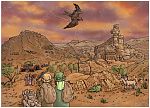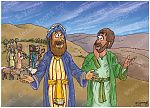Bible Cartoon: Genesis 12 - Call of Abram - Scene 06 - Into the Negev (Version 02)
Click on Add to cart button below shopping cart.
Purchased Bible Cartoons do not have watermarks. Links to Cartoons provided on email once purchase is completed.Bible Book: Genesis
Bible Book Code: 0101200902
Scene no: 6 of 6
Bible Reference & Cartoon Description
Genesis 12:9 (NLT)
Then Abram continued travelling south by stages toward the Negev.
DRAWING NOTES:
TIME OF DAY:
Unspecified in Bible narrative, I have made it mid afternoon in this version.
LIGHTING NOTES:
The desert sun (off to the right) illuminates this scene, casting shadows below and to the left of figures and objects.
CHARACTERS PRESENT:
In the foreground are various un-named members of Abram’s group, all walking to his encampment in the middle distance.
RESEARCH/ADDITIONAL NOTES:
This picture shows the stragglers of Abram’s household arriving at his encampment in the Negev.
Notice the two young goat-like animals on the right foreground are Capra nubiana (Nubian ibex), which inhabits the desert regions of the Middle East, as well as the Itbay region of Sudan and Egypt. They are the smallest ibex species and adapted for arid environments with a tan color, white underbelly and rump, black legs, and dark tail.
The bird swooping down in the sky is Milvus migrans (aka the Black Kite). This is a medium-sized bird of prey in the family Accipitridae, which also includes many other diurnal raptors. Unlike others of the group, black kites are opportunistic hunters and are more likely to scavenge. They spend much time soaring and gliding in thermals in search of food. Their angled wing and distinctive forked tail make them easy to identify. They are also vociferous with a shrill whinnying call. The black kite is widely distributed through the temperate and tropical parts of Eurasia and parts of Australasia and Oceania, with the temperate region populations tending to be migratory. Several subspecies are recognized and formerly had their own English names. The European populations are small, but the South Asian population is very large.
Black kites can be distinguished from red kites by the slightly smaller size, less forked tail (visible in flight), and generally darker plumage.
Notice the flocks and herds of animals the shephards are bringing into the camp of Abram.
There are two versions of this scene:
01) (Previous page) Genesis 12 – Call of Abram – Scene 06 – Into the Negev (Version 01). In this version the sky is darker (sunset), as are the rocks.
02) (This page) Genesis 12 – Call of Abram – Scene 06 – Into the Negev (Version 02). In this version I have made the sky and rocky landscape brighter.
A note about the Negev
Negev – desert region, Israel.
Also known as: Al-Naqab, Ha-Negev, Negeb, the Southland.
The Negev, arid region in the southern part of Israel and occupying almost half of Palestine west of the Jordan River and about 60 percent of Israeli territory under the 1949–67 boundaries. The name is derived from the Hebrew verbal root n-g-b, “to dry” or “to wipe dry.” The Negev is shaped like a triangle with the apex at the south. It is bounded by the Sinai Peninsula (west) and the Jordan Valley (east). Its northern boundary—where the region blends into the coastal plain in the northwest, the Judaean Hills (Har Yehuda) in the north, and the Wilderness of Judaea (Midbar Yehuda) in the northeast—is indistinct. Many use an arbitrary line at about 30°25’ N latitude for the northern boundary. Within these limits, the Negev has an area of about 4,650 square miles (12,000 square km).
[Source: https://www.britannica.com/place/Negev]
The Negev (Hebrew “dry”; in the Hebrew Bible, the word Negev is also used for the direction ‘south’) is a desert and semidesert region of southern Israel. The region’s largest city and administrative capital is Beersheba in the north. At its southern end is the Gulf of Aqaba and the city port of Eilat.
The Negev mentioned in the Bible only consisted of the northern most part of the modern Israeli Negev, with the semiarid Arad-Beersheba Valley defined in the Bible as “the eastern Negev”.
The Negev covers more than half of Israel, over 5,000 square miles (13,000 km2), or at least 55% of the country’s land area. It’s shape forms an inverted triangle, whose western side is contiguous with the desert of the Sinai Peninsula, and whose eastern border is the Arabah valley. The Negev has a number of interesting cultural and geological features. Among the latter are three enormous, craterlike makhteshim (box canyons), which are unique to the region: Makhtesh Ramon, HaMakhtesh HaGadol, and HaMakhtesh HaKatan.
Vegetation in the Negev is sparse, but certain trees and plants thrive there, among them Acacia, Pistacia, Retama, Urginea maritima and Thymelaea. Hyphaene thebaica or doum palm can be found in the Southern Negev. The Evrona Nature Reserve is the most northerly point in the world where this palm can be found.
Here’s the scene without the figures and animals in the fore and middle ground.

Click on the colour bar below to view/buy this Background:
Background of Genesis 12 – Call of Abram – Scene 06 – Into the Negev (Version 02)
Click colour bar below to read the full Encylopaedia article about the Negev:
Encyclopaedia article: The Negev

Map of Sothern Israel showing the Negev
Link to related Map
Click colour bar below to see the Map showing the Negev, with purchase option:
View/Buy Map





